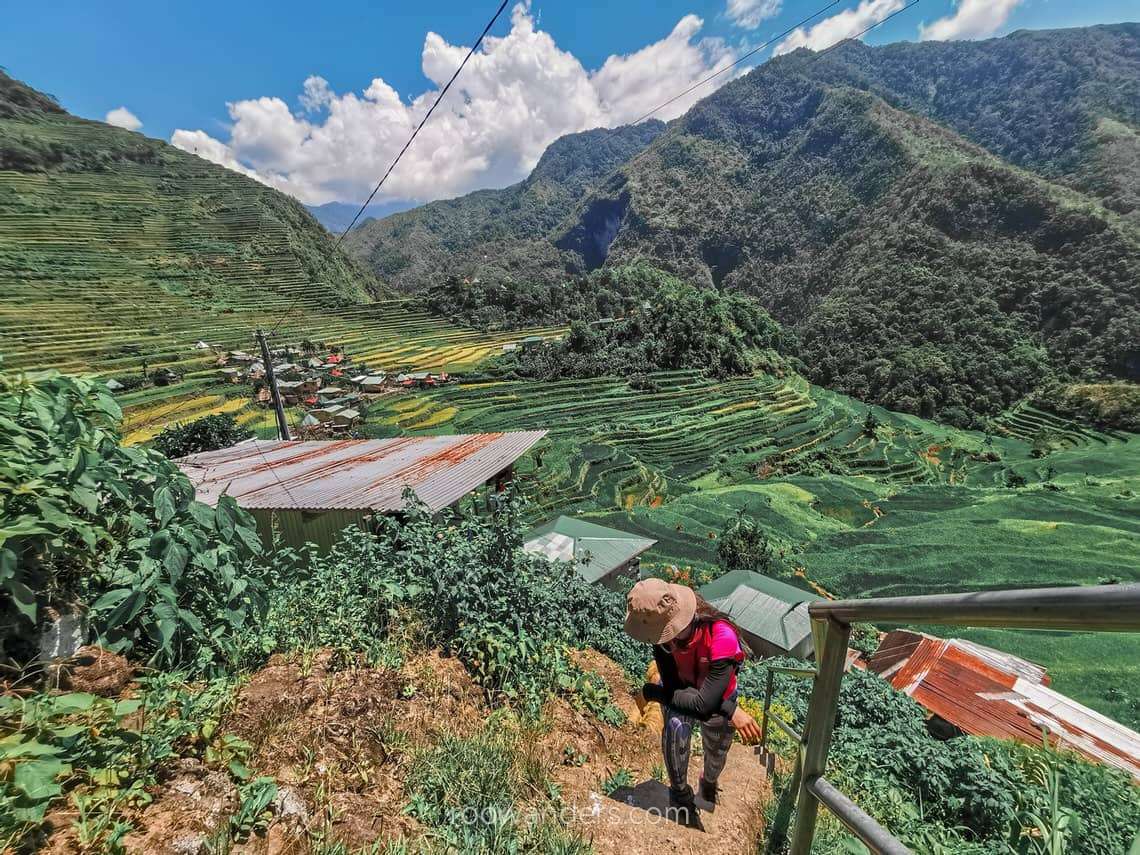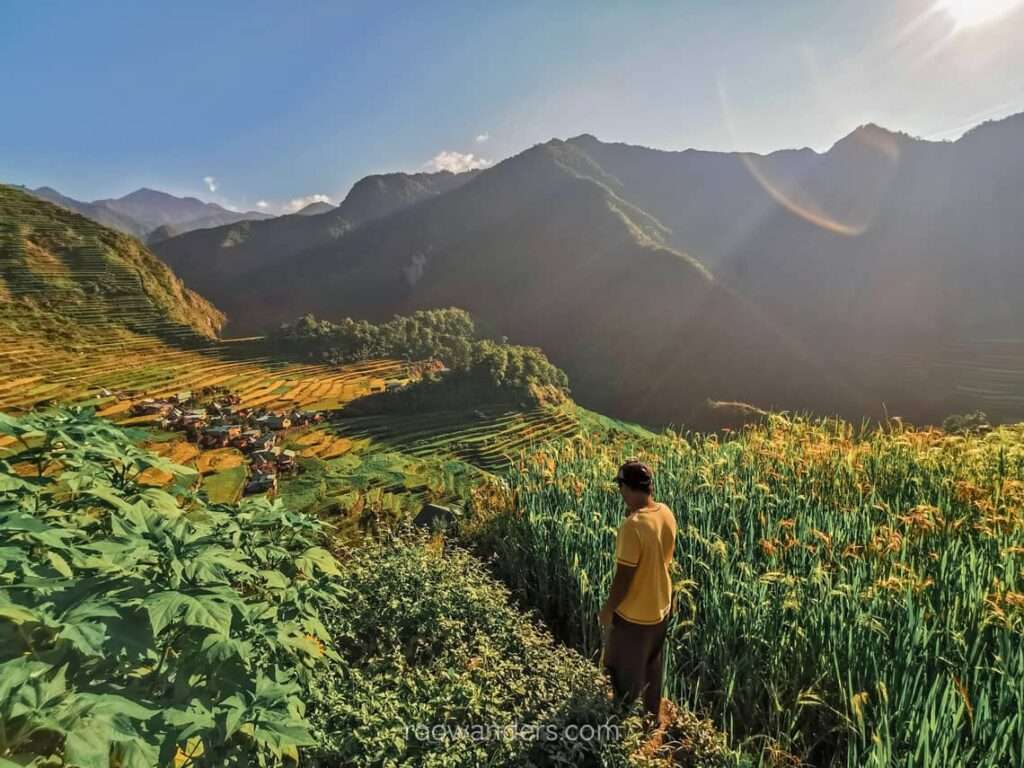
Awa View Deck: A Fantastic Hike in Batad
Batad is a great place to unwind and soak in the tranquillity the rice terrace valley has to offer. You get no reception – no emails or messages to answer! – beautiful tracks within and around its vicinity, and dramatic portrayal of sunrise and sunset.
But with limited time on our side – a 5-day trip, taking advantage of a long weekend! – we have only a day and a half to maximise. Tappiya Waterfall aside, the Awa View Deck is the next attraction any fit or adventurous visitor should visit.
Of course, if you’ve been a long-time reader of my blog, you’ll know I’ll never miss this hiking opportunity amongst the centuries-old lush terraces of Ifugao!
I trekked to Awa View Deck and visited Batad and Ifugao in May 2019. This post may be updated periodically. The post contains affiliate links that cost nothing to you but support my blog. Cheers!
Brief Info about Awa View Deck
Before I dive into this section about Awa View Deck, you have to be in Batad. Read more about how to get to Batad towards the end of this post, or my guide to Batad.
Awa View Deck, situated at the top of the amphitheatre-like rice terraces of Batad, is an observation deck with excellent views. You cannot fully appreciate the vastness of the rice terraces until you’re up at the deck with the unobstructed view. Photos show but they can never replace seeing the view in real life.

Getting there requires fitness as it takes about half a day or 4-5 hours for a return trip. So start your training!
The locals also use the pass to travel between Batad and its neighbouring village, Sitio Patpat.
While you may be tempted to try this walk unguided – maybe from reading my post – refrain! The trek isn’t well-demarcated, and there are places with narrow paths beside steep drops. Get a local guide for P800 – 1200 to stay safe.
My Trekking Experience
An Early Start
We set off before 8 AM, as Ifugao pretty much pours in the late afternoon every day during our trip. Also, we had an overnight bus to catch from Banaue back to Manila!
First off, the steps and the levees – pilapil – around the rice terraces. They are uneven. They are steep. And they can get darn slippery if they’re wet.

If you’re staying at the upper level of the valley, prepare to descend till the bottom. For us, we stayed at Lhoren’s Inn, which is close to the bottom, and did not take long to reach the path into the forest.

The Metal Bridge
Our next landmark was a metal bridge painted with orange rust. Getting across this bridge was a little iffy as the railings have holes big enough for one to accidentally slide through, and metal surface slippery enough to help with that. The turbulent river and rocky rocks underneath the bridge did not help either.

Holding onto the rails leaves your hands smelling like old rusty cans.
Through the Forest
Leaving the rusty bridge behind, we ascended through the forest towards the Deck. Sounds easy but it is all but that.
There were slippery spots of mud-sand-foliage, and the harrowing experience of stepping on little rocks perched beside a wall, presumably from an abandoned terrace. Then more balancing over the foot-wide levee covered in moss and more dead leaves.
This whole balancing and navigating act required strong thigh muscles, balancing, and concentration, and made talking very difficult, which was what we had been doing with our guide Ramon since the morning.
Spring Water
Somewhere in between the trek, we passed by a small stream. Ramon whipped out his plastic bottle and started filling his bottle. We took a risk with our fragile city bellies and tried a few sips of the tasty water too, which was cool and slightly sweet from the natural minerals. Lucky for us, nothing bad happened.
The Awa View Deck
After more climbing over rocks and slippery foliage, we were finally at the Deck!
Breathtaking views aside, the cooling winds after hours of hiking in the stifling humidity were equally breathtaking. The narrow passage is a pass between two valleys, which probably explains the frequent strong winds.


As we marvelled at the view over some snack bars, a woman with stained teeth from too many betel nuts like Ramon heaved up a basket of bananas from the other side of the pass. She had made her way up with the heavy bunch of bananas propped on her head to sell in Batad. I find it incredible that locals like Ramon and the women could get around in flimsy $2 slippers when visitors like us were wearing hiking boots and still worried about our footing.
We continued to spend some time enjoying the view and the breeze before heading back down the same way.
Back to the Village
Going down was as much a challenge as heading up.
As we retraced the route down, Ramon recounted some near-misses, like how a trip he led some weeks ago had one of the hikers almost falling down a cliff. I can attest that the bushes are thick, and you cannot know for sure if it’s a cliff behind the shrub.
We leveraged on roots, rocks and branches to get down sections that were too steep and a bit too muddy.
Sweat poured through all pores by the time we reached Lhoren’s Inn given the poisonous sun hanging high atop and the high humidity. A refreshing shower was all we needed!

Getting to Batad
Getting to Batad is not that simple. To reach Batad independently, start from the closest town, Banaue. Board an overnight bus from Manila to Banaue either via Coda Lines or Ohayami.
Once in Banaue, hop onto a jeepney that operates once a day – as other blogs reported – or hire a private trike to reach Saddle Point. This journey typically takes around one hour. We went with a trike as we couldn’t find the jeepney.

Trike
It costs P350 per person (as of May 2019) for the trike that accommodates two.
The journey was an experience – loud and noisy coupled with the stench of diesel fumes. Bring earplugs and a bandana or mask to make the trip more bearable.
Hike
Think you’ve reached Batad after alighting from the trike or jeepney? Not so fast! You still have to hike down a series of steps from Saddle Point to reach the rice terraces. No vehicles can cruise through Batad’s steps and narrow lanes. Buffer for around 15 – 30 mins depending on your stamina.
Best Time to Visit Batad
Batad maintains a cool climate throughout the year, in contrast to Manila, as it is in the hilly Ifugao region.
Depending on your preferences and interests, here’s what you can expect in the different months:
April to June and October to November: The rice terraces are green and lush, ready for harvesting. However, you’ll get occasional showers in the late afternoon.
My visit happened in May 2019, and we had rain every day, mostly after 3 pm. So plan your activities in the morning or early afternoon before the rain party. Don’t forget a poncho or a rain jacket! If it doesn’t rain, resist the temptation to hike around sunset ~5 pm. Don’t be that clown that’s lost in the forest at night needing help.

December to February and July to September: These periods coincide with either the harvest or planting season, resulting in less than ideal green terraces. However, if your visit is before the harvest, you may see golden brown terraces instead! December to February is also the coldest time of the year.
If you prefer to avoid large crowds, stay away from visiting during Christmas and Holy Week.
Where to Stay in Batad
Despite its secludedness, pre-booking accommodation in Batad is actually very easy. There are plenty of options online.
We went with Lhoren’s Inn after hearing raving reviews from a friend. Lhoren cooks delicious chicken adobo, and we even had the chance to taste homemade rice wine during late-night conversations with her and her husband.

If you don’t fancy walking down to the valley or want a room with superb mountain views, check out Batad Countryside or Highland Inn and Restaurant. Both are on higher elevations compared to Lhoren’s Inn. Judging from the reviews, these two places have great hosts and offer superb hospitality too.

Keep in mind that food and drinks in Batad may be slightly more expensive, as they need to be transported from Banaue – cue the road and trail.
Side Stories from Ramon
I thought I’ll capture some bits of info here with our guide Ramon in this section.
Ramon shared with us the history and stories of Batad. We even had a chance to visit a family who happened to be sieving their rice during our trek.
According to Ramon, the rice produced in Batad is insufficient to support the whole village. Most of the rice they eat now is ironically imported from Vietnam or Thailand.
The young have left the village for the cities, which is understandable as Batad has poor reception. You cannot work remotely in Batad! But some stayed behind, determined to preserve the tradition and family heritage of their centuries-old terraces.
Ending
Visiting Awa View Deck was an achievement and the highlight of my visit to Batad. While the hike is a challenge, it is not overly strenuous for someone with decent fitness. As a person who has been to several hikes in Malaysia, of which the hardest being the Mulu Pinnacles in Sarawak, the forested hike towards Awa View Deck is highly doable.
Just make sure you’ve done enough stairs before your trip. Hiking sticks are pretty redundant so leave that behind. Take your time and enjoy the process and savour the view from the top!

Key Pointers
- Have enough cash. We did not encounter any ATMs in Batad. Then again, I did not expect any when the village is that secluded. Bring at least P1000 for a 2D1N trip in Batad. Exchange in Banaue.
- Train for stairs. Lots of stair-climbing to do in Batad. Use the hills or skyscrapers around you and train!
- Bring hiking sticks. According to the guide and Lhoren. You could borrow wooden sticks from them too. We didn’t use any as they were a burden on the stairs.
- Get a guide. They are knowledgeable, have stories to share and would ensure your safety. Hire fee: P800 – 1200/ trip, depending on the guide and places you’re going.
- Buy your bus tickets early. You don’t want to miss your bus to Manila or jeopardise your trip.
- Bring ponchos/ umbrellas. Protect yourself against the 3 pm rain.







